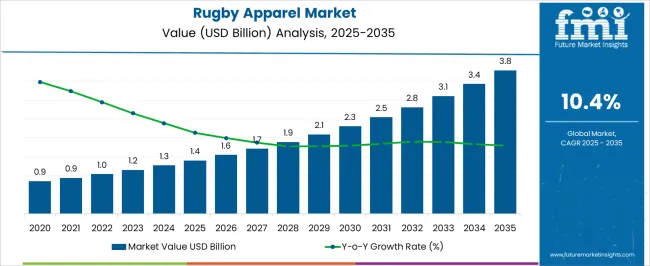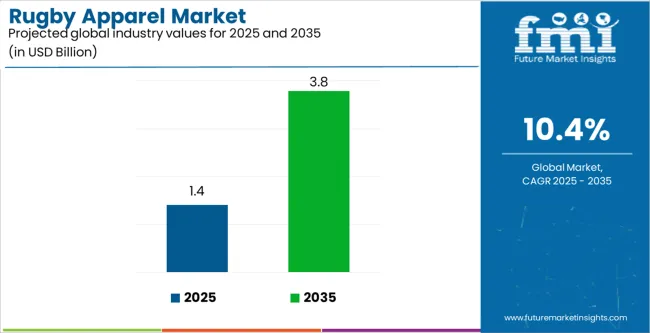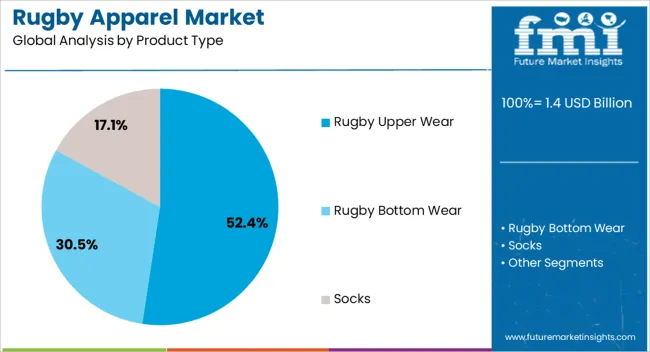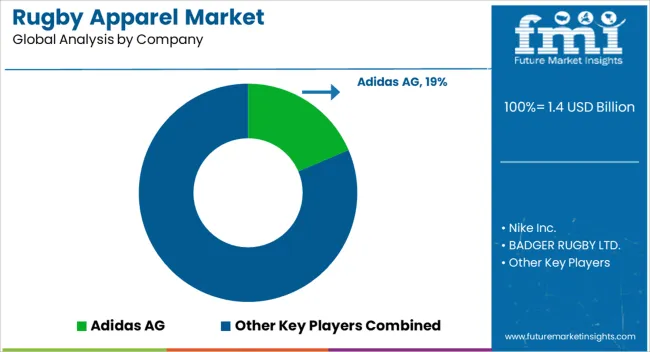The rugby apparel market is exhibiting steady growth, supported by the sport’s expanding global fan base and increasing participation across amateur and professional levels. Industry publications and sportswear brand press releases have emphasized rising investments in performance-oriented apparel tailored to rugby’s physical demands. Technological advancements in moisture-wicking, stretchable, and impact-resistant fabrics have redefined product standards, prompting apparel manufacturers to launch specialized lines.
Rugby clubs, schools, and regional leagues have also contributed to sustained demand, driven by growing institutional purchases and merchandising opportunities. Strategic partnerships between rugby federations and sportswear brands have improved brand visibility and promoted standardized kit adoption.
Additionally, the growing popularity of international tournaments and national leagues has spurred demand for licensed merchandise, with apparel sales gaining momentum through both offline and e-commerce retail. Looking forward, market expansion is expected to continue through customized jersey offerings, eco-friendly fabrics, and region-specific designs that cater to evolving consumer preferences. Segmental momentum is being led by rugby upper wear, which dominates due to its high visibility, frequent replacement cycles, and alignment with team branding and sponsorships.


| Metric | Value |
|---|---|
| Rugby Apparel Market Estimated Value in (2025 E) | USD 1.4 billion |
| Rugby Apparel Market Forecast Value in (2035 F) | USD 3.8 billion |
| Forecast CAGR (2025 to 2035) | 10.4% |
The market is segmented by Product Type and region. By Product Type, the market is divided into Rugby Upper Wear, Rugby Bottom Wear, and Socks. Regionally, the market is classified into North America, Latin America, Western Europe, Eastern Europe, Balkan & Baltic Countries, Russia & Belarus, Central Asia, East Asia, South Asia & Pacific, and the Middle East & Africa.

The Rugby Upper Wear segment is projected to hold 52.4% of the rugby apparel market revenue in 2025, maintaining its position as the dominant product category. Growth in this segment has been driven by the essential nature of upper body gear in rugby, including jerseys, training shirts, and compression tops, which are integral to both player performance and team identity.
Apparel designed for the upper body has been prioritized by manufacturers due to the need for durable, breathable, and stretchable materials that withstand intense contact during gameplay. Sportswear brands have continued to invest in the development of upper wear that balances comfort, mobility, and moisture control, reflecting the sport’s physical intensity.
Moreover, upper wear serves as a key branding element, often featuring team logos, sponsors, and country colors, which amplifies consumer demand across retail channels. As rugby apparel trends evolve toward customization, limited-edition designs, and replica fan merchandise, the Rugby Upper Wear segment is expected to remain at the forefront of the market’s product demand.
Global Rugby Expansion Fuels Demand for Specialized Gear
One key driver of the rugby apparel landscape is the ascending global popularity of the sport. As rugby gains traction in new regions and attracts a larger fan base worldwide, a corresponding upsurge in demand for rugby-specific clothing and gear can be seen.
The growth is fueled by factors such as the expansion of international competitions, rise in media coverage, and efforts to promote the sport at grassroots levels.
Manufacturers and retailers are capitalizing on this trend by offering a diverse range of products to cater to the needs and preferences of rugby players and enthusiasts across different demographics and regions.
Customization of Personalized Performance Wear
Customization emerges as a significant trend in the rugby apparel industry, reflecting a shift towards personalized performance wear. Players and teams seek unique designs and features tailored to specific needs and preferences.
The trend is facilitated by advancements in technology, allowing for intricate customization options, from team logos and colors to individual player names and numbers.
Manufacturers and retailers are responding by offering customizable rugby jerseys, shorts, and accessories, empowering players to express identity on the field while enhancing performance and team cohesion.
Limited Market Reach in Non-Traditional Rugby Regions
A significant challenge facing the rugby apparel industry is the limited sectorial reach in non-traditional rugby regions.
Availability of regions where rugby remains relatively niche compared to other sports presents a challenge for apparel manufacturers and retailers seeking to expand customer base.
Overcoming this obstacle requires targeted marketing strategies, grassroots initiatives to promote the sport, and partnerships with local organizations to increase awareness and participation. Adapting product offerings to suit the preferences and needs of diverse industries is essential for sustained growth.
The rugby apparel market growth over the past few years has a historical CAGR of 6.6% from 2020 to 2025. The growth can be attributed to the surge in popularity of rugby as a global sport, advancements in apparel technology enhancing product performance and comfort, and the rise in demand for sports-specific clothing and accessories.
Looking ahead to the forecast period from 2025 to 2035, the industry is poised for even stronger growth, with a projected CAGR of 10.4%. The continued expansion of rugby's global footprint is anticipated to augment demand for rugby apparel in both traditional and emerging sectors. The sport gains popularity in regions beyond its traditional strongholds, such as North America and Asia, a corresponding surge in the consumer base for rugby-related products.
The growing emphasis on health, fitness, and active lifestyles is expected to contribute to the upsurge in demand for sports apparel, including rugby-specific gear. With the rise in the number of individuals participating in recreational and amateur rugby leagues, a heightened need for high-quality, performance-oriented apparel and equipment can be seen.
Advancements in material science and manufacturing techniques are likely to propel innovation within the rugby apparel industry, leading to the development of cutting-edge products that offer enhanced performance, durability, and comfort.
The table represents the top five countries ranked by revenue, with India holding the top position.
The industry is led significantly by sales of the rugby apparel industry in India, the United States, and China. Asia Pacific region, emerges as a key industry at a global level, followed by North America.
The Forecast CAGRs from 2025 to 2035
| Countries | CAGR |
|---|---|
| The United States | 7.8% |
| Germany | 6.8% |
| China | 17.2% |
| India | 19.5% |
| Australia | 12.6% |

Government funding for sports and rugby development programs at the grassroots level in the United States plays an important role in fostering athletic talent, promoting healthy lifestyles, and building strong communities.
Investment in such programs leads the government not only to cultivate a love for the sport but also to address societal issues like obesity and juvenile delinquency.
The industry creates opportunities for disadvantaged youth to engage in constructive activities, potentially steering them away from negative influences. Additionally, such funding bolsters the country's sporting competitiveness on the global stage, nurturing future athletes who may represent the nation internationally.
E-commerce has revolutionized the rugby apparel market in India, offering convenience, variety, and accessibility to enthusiasts nationwide. The online platform enables customers to browse through a wide range of products, compare prices, and make purchases from the comfort of homes.
The accessibility transcends geographical barriers, reaching regions where traditional retail infrastructure may be lacking. E-commerce platforms facilitate targeted marketing efforts, tailoring promotions to specific consumer interests.
The rugby apparel industry in India experiences significant growth, augmented by the seamless integration of technology and commerce, catering to the evolving preferences of consumers in this niche sporting segment.
Regulations on product safety and labor standards in the apparel manufacturing industry in China are vital for safeguarding consumer health and worker welfare. Stringent measures are in place to ensure compliance with quality standards, preventing the distribution of substandard or hazardous products.
Labor regulations aim to uphold fair working conditions, including reasonable wages, reasonable working hours, and safe environments. Government agencies, industry associations, and international organizations collaborate to enforce the regulations, conducting inspections, audits, and certifications to maintain industry integrity.
In the subsequent section, the pivotal segments influencing the rugby apparel industry are scrutinized and illustrated through data from research. Based on product type, the upper wear segment is estimated to account for a share of 51.5% in 2025. By region, North America is projected to dominate by holding a share of 56.9% in 2025.
| Attribute | Details |
|---|---|
| Product Type | Upper Wear |
| Value Share in 2025 | 51.5% |
Based on the product type, the upper wear segment is accounted to hold a market share of 51.5% in 2025. The segment signifies the significance of jerseys, shirts, and other upper body apparel within the rugby apparel market.
The trend reflects the essential role of upper wear in both performance and identity within the sport. Jerseys, for instance, not only serve as functional garments but also represent a team's colors, emblem, and tradition, fostering a sense of unity and pride among players and fans alike.
The durability and performance features incorporated into upper wear, such as moisture-wicking fabrics and ergonomic designs, cater to the physical demands of rugby while enhancing player comfort and performance on the field.
| Attribute | Details |
|---|---|
| Region | North America |
| Value Share in 2025 | 56.9% |
Based on region, the North America segment is accounted to hold a market share of 56.9% in 2025, underscoring the region's growing influence and investment in the sport.
The ecosystem can be attributed to the rise in popularity of rugby among North American youth and college students, as well as the expansion of professional leagues and grassroots initiatives aimed at promoting the sport.
North America's strong sporting culture, coupled with its affluent consumer base and robust infrastructure for sports retail, positions the region as a key market for rugby apparel manufacturers and retailers seeking growth opportunities.
The region's diverse population and multiculturalism contribute to the vibrant and inclusive rugby community, augmenting demand for a wide range of apparel products tailored to different preferences and demographics.

The competitive landscape of the rugby apparel industry showcases a dynamic interplay between established players, emerging startups, and niche market segments. Major sportswear brands like Adidas and Nike dominate with extensive product offerings and global reach. Start-ups bring innovation and agility to the market, catering to niche segments such as customizable rugby apparel or sustainable options.
The start-ups leverage technological advancements, such as 3D printing and digital customization platforms, to differentiate themselves and capture market share.
Niche markets, such as premium rugby apparel for elite athletes or retro-inspired designs for vintage enthusiasts, provide opportunities for specialized brands to thrive by offering unique products tailored to specific customer preferences and lifestyles.
Industry Updates
In 2025, Adidas AG collaborated with a project with prominent rugby teams to co-create innovative performance wear. The initiative involved close collaboration with professional players to design and develop rugby apparel that meets the specific demands of the sport, focusing on aspects such as durability, flexibility, and moisture management.
In 2025, Nike Inc. introduced a line of sustainable rugby apparel. The initiative aligned with Nike's commitment to sustainability and environmental responsibility, addressing growing consumer concerns about the ecological footprint of clothing production. Nike's sustainable rugby apparel line utilized eco-friendly materials, such as recycled polyester and organic cotton, while also incorporating innovative manufacturing processes to minimize waste and resource consumption.
The market is classified into rugby upper wear, rugby bottom wear, and socks.
Analysis of the market has been carried out in key countries of North America, Latin America, Western Europe, South Asia, East Asia, Eastern Europe, and the Middle East and Africa.
The global rugby apparel market is estimated to be valued at USD 1.4 billion in 2025.
The market size for the rugby apparel market is projected to reach USD 3.8 billion by 2035.
The rugby apparel market is expected to grow at a 10.4% CAGR between 2025 and 2035.
The key product types in rugby apparel market are rugby upper wear, rugby bottom wear and socks.
In terms of , segment to command 0.0% share in the rugby apparel market in 2025.






Our Research Products

The "Full Research Suite" delivers actionable market intel, deep dives on markets or technologies, so clients act faster, cut risk, and unlock growth.

The Leaderboard benchmarks and ranks top vendors, classifying them as Established Leaders, Leading Challengers, or Disruptors & Challengers.

Locates where complements amplify value and substitutes erode it, forecasting net impact by horizon

We deliver granular, decision-grade intel: market sizing, 5-year forecasts, pricing, adoption, usage, revenue, and operational KPIs—plus competitor tracking, regulation, and value chains—across 60 countries broadly.

Spot the shifts before they hit your P&L. We track inflection points, adoption curves, pricing moves, and ecosystem plays to show where demand is heading, why it is changing, and what to do next across high-growth markets and disruptive tech

Real-time reads of user behavior. We track shifting priorities, perceptions of today’s and next-gen services, and provider experience, then pace how fast tech moves from trial to adoption, blending buyer, consumer, and channel inputs with social signals (#WhySwitch, #UX).

Partner with our analyst team to build a custom report designed around your business priorities. From analysing market trends to assessing competitors or crafting bespoke datasets, we tailor insights to your needs.
Supplier Intelligence
Discovery & Profiling
Capacity & Footprint
Performance & Risk
Compliance & Governance
Commercial Readiness
Who Supplies Whom
Scorecards & Shortlists
Playbooks & Docs
Category Intelligence
Definition & Scope
Demand & Use Cases
Cost Drivers
Market Structure
Supply Chain Map
Trade & Policy
Operating Norms
Deliverables
Buyer Intelligence
Account Basics
Spend & Scope
Procurement Model
Vendor Requirements
Terms & Policies
Entry Strategy
Pain Points & Triggers
Outputs
Pricing Analysis
Benchmarks
Trends
Should-Cost
Indexation
Landed Cost
Commercial Terms
Deliverables
Brand Analysis
Positioning & Value Prop
Share & Presence
Customer Evidence
Go-to-Market
Digital & Reputation
Compliance & Trust
KPIs & Gaps
Outputs
Full Research Suite comprises of:
Market outlook & trends analysis
Interviews & case studies
Strategic recommendations
Vendor profiles & capabilities analysis
5-year forecasts
8 regions and 60+ country-level data splits
Market segment data splits
12 months of continuous data updates
DELIVERED AS:
PDF EXCEL ONLINE
Apparel Market Size and Share Forecast Outlook 2025 to 2035
Apparel Re-commerce Market Size and Share Forecast Outlook 2025 to 2035
Gym Apparel Market Size and Share Forecast Outlook 2025 to 2035
Pet Apparel Market Analysis - Size, Demand & Forecast 2025 to 2035
Chef Apparel Market Size and Share Forecast Outlook 2025 to 2035
Kids Apparel Market Trends - Growth, Demand & Forecast 2025 to 2035
Blank Apparel Market – Growth & Demand Forecast 2025 to 2035
Bamboo Apparel Market Size and Share Forecast Outlook 2025 to 2035
Outdoor Apparel and Accessories Market Size and Share Forecast Outlook 2025 to 2035
Sequins Apparel Market Size and Share Forecast Outlook 2025 to 2035
TIC For Apparel Market
Crossfit Apparel Market Size and Share Forecast Outlook 2025 to 2035
Maternity Apparel Market Size and Share Forecast Outlook 2025 to 2035
Decorated Apparel Market segmented by Product, End-user and Distribution Channel through 2025 to 2035
Market Share Distribution Among Maternity Apparel Providers
Equestrian Apparel Market Size and Share Forecast Outlook 2025 to 2035
Secondhand Apparel Market Analysis - Size, Share, and Forecast 2025 to 2035
Competitive Overview of Secondhand Apparel Market Share
Second-hand Apparel Market in Europe Analysis - Size, Share, and Forecast Outlook 2025 to 2035
The Dye Sublimated Apparel Market is segmented by product, printing technique, distribution and region through 2025 to 2035.

Thank you!
You will receive an email from our Business Development Manager. Please be sure to check your SPAM/JUNK folder too.
Chat With
MaRIA